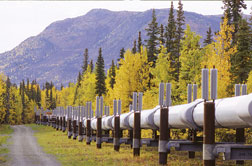 Massachusetts Water Resources Authority Deer Island treatment plant was elevated for climate change.
|
Nowhere is this understood better than in the Arctic, where ice packs that have long protected shoreside villages from storms are withdrawing, and where the permafrost that bears the loads of columns, beams and roadbeds is threatened by the change of a single temperature degree.
“We are on the phase-change line for global climate change,” says Duane Miller, a geotechnical engineer and principal of Duane Miller Associates LLC, Fairbanks, Alaska. “Alaska is the canary in the weather system.”
The science behind climate change prediction is convincing, Miller says, particularly with what he has seen. “On any job where we have permafrost, the changing climate is definitely a consideration,” Miller says. Contractors have sunk hundreds of thousands of passive thermal siphon piles around foundations of pipelines, towers, buildings and other infrastructure. The piles draw subsurface heat off and exchange it for cold from frigid winter air to help the permafrost hold its own through the ever warmer summers. Newer versions of the piles are hybrids that can be converted to active refrigeration, if need be, in the future.
|
“We have to ask ourselves, if we design it this way, what’s going to be the case 25, 30 years from now? Normally, in engineering, your hindcast does not assume a temporal change in the future…but that’s what we are up against now,” Miller says.
But you do not have to go to the Arctic to find planners factoring in growing uncertainty about long-held assumptions such as snow and rainfall patterns, storm seasons and mean sea level.
Water and sewer utility planners in Boston caught on early, says Paul H. Kirshen, a civil engineering research professor at Tufts University, Medford, Mass. Kirshen was lead author on a five-year study completed in 2004 about the impact of climate change on the Boston metropolitan area. He says water utility planners there are “ahead of the curve.”
The general circulation climate models Kirshen used, which are becoming increasingly refined and accepted, predict an average temperature rise in Boston of 6ºF to 10°F by 2100 and a sea level rise of 24 to 39 in. from the combined effects of increased ocean volume, melting land ice and land subsidence. It also predicts more inland flooding from heavy rains, a loss of wetlands, more concentrated air pollution and greater energy demand.
The Massachusetts Water Resources Authority has been making choices since 1986 that may help lessen the impact. That year, prodded by federal pressure to clean up Boston Harbor, the authority decided the best way to curb pollution and build a more robust system was to push demand down and ratchet up efficiency and conservation, says Stephen Estes-Smargaissi, director of planning. It was not a case of applying engineering to confront potential climate change so much as consciously picking alternatives that also had the potential to moderate the effects of climate change, should it occur, he says.
 Alyeska Pipeline Service Co. Thermal siphons on the Alaska pipeline protect permafrost.
|
“Water conservation makes our system more robust,” says Estes-Smargaissi. Other initiatives included expanding inter-ties with the region’s smaller utilities, whose limited storage capacity was more likely to be overwhelmed in big rain events than the larger regional ones. Through interties, the regional system absorbs excess and then pays back the small systems when dry periods strain their supplies. “We also plugged leaks, changed the toilet code and raised the prices,” says Estes-Smargaissi. “That got people’s attention and conveyed the overall sense that water is an important resource. It means that if the climate changes and if we have less resources or they are more variable, we have a lot more robust system than we had 15 years ago.”
Downward Spiral
The numbers track the results. In 1980, the authority served 2.1 million people by pumping 340 million gallons of water a day. Today, it meets the needs of about 2.4 million people with significantly less water—212 mgd, Estes-Smargiassi says. “Having a regional system that’s responsive to climate change is something
he particulars of climate change and sea-level rise will bedevil planners and engineers for decades to come. How much, how fast and where the impacts will fall are uncertainties that have the potential to shift many of the assumptions used in the profession.